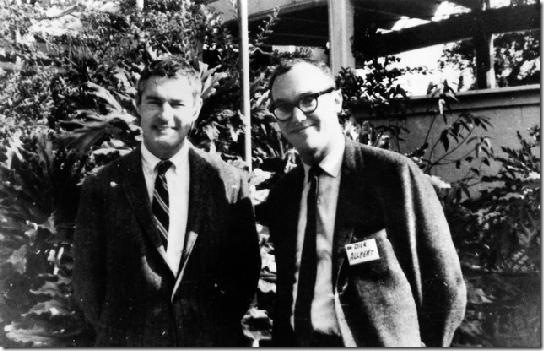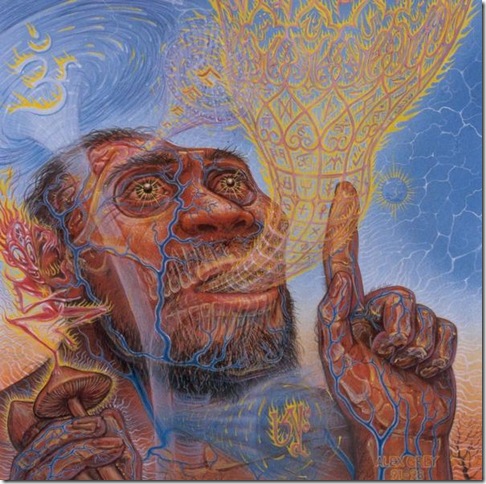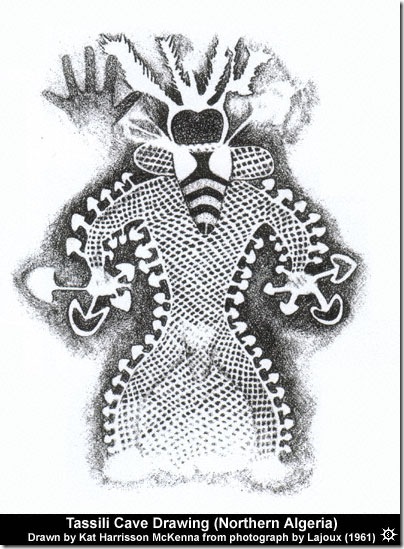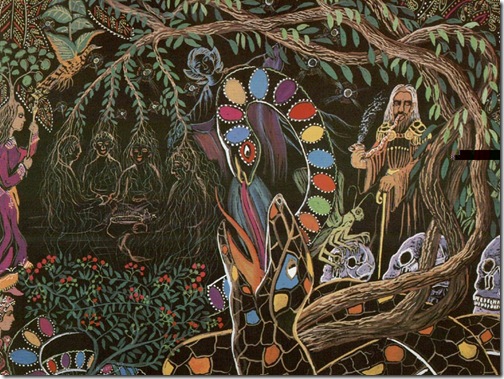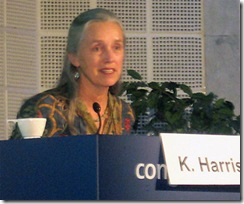
By: Charles Eisenstein
From: Reality Sandwich
Once upon a time, our distant ancestors were animists who believed in the innate divinity of all things. Spirit was a property of matter, and all things possessed it: not just plants and animals but also rocks, clouds, lakes, wind, places, and every natural thing and process. I said all things possessed spirit, but that isn't quite what the original animists believed. Spirit was not something separate from matter, to be possessed or not. Matter was inherently spiritual.
As the human realm gradually separated from the natural (in perception if not in reality), we began to separate spirit from matter. The first step away was to believe all things to possess spirit. This is the belief that characterizes the pagan religions. In ancient Greek religion, for example, everything from the ocean and the sky down to the smallest shrub or stream had a divinity associated with it. The ancient pagans still lived in a fully enspirited world where everything was sacred.
As time passed and the mentality of agriculture tightened its grip, the human and natural realms separated still further and we began to believe that some things possessed spirit and others did not. Spirit became increasingly abstracted from matter, culminating in twin developments at the dawn of the modern era. On the one hand, Protestantism reduced the participation of divinity in the world to the sole figure of Jesus Christ, replacing the Catholic pantheon of saints with a single divine individual, just as the saints had replaced the even more participatory pagan panentheism. On the other hand, scientists like Galileo, Descartes, and Newton reduced Creation to a single event as well in their conception of a clockwork universe, created and wound up by God to tick on, mechanically and everlastingly, henceforward. In the equations of Newton, the ongoing participation of a divinity in naure was no longer necessary.
The late stone-age people and early agriculturalists that we call pagan recognized, perhaps unconsciously, this progressive desacralization of the world. They knew that the separateness of the human realm is an illusion, that we too are bound by the laws of nature and that it is necessary sometimes to remind ourselves of that. It is necessary sometimes to remind ourselves of the sacredness and divinity of all things. It is necessary sometimes to reconnect to the Wild. Rituals developed to meet these needs. Some cultures recognized this explicitly, such as the Yurok of the Pacific Northwest who, in the words of Joseph Epes Brown,
"believed that, in the beginning, the world was inhabited by the wo'gey, or Immortals, who knew how to live in harmony with the earth. The wo'gey departed when the humans arrived. Yet, because they knew that humans did not always follow the laws of the world, they taught them how to perform ceremonies that could restore the earth's balance." [1]
Halloween originates in the same spirit. The holiday we celebrate today has roots in the ancient Celtic holiday of Samhuinn, which, in the words of Philip Carr-Gomm, was
"a time of no-time. Celtic society, like all early societies, was highly structured and organized, everyone knew their place. But to allow that order to be psychologically comfortable, the Celts knew that there had to be a time when order and structure were abolished, when chaos could reign. And Samhuinn, was such a time. Time was abolished for the three days of this festival and people did crazy things, men dressed as women and women as men. Farmers' gates were unhinged and left in ditches, peoples' horses were moved to different fields." [2]
The agricultural mindset divides the world into two parts, the domestic and the wild, and seeks to maintain and expand the former as it conquers the latter. The domestic is good, the wild is bad. The corn is good, the weed is bad. The sheep is good, the wolf is bad. The orderly is good, the chaotic is bad. But the pagan farmer recognizes that this division is not the ultimate reality, and seeks to maintain a healthy connection to the underlying panentheistic truth, lest she forget that she too is governed by nature's laws. For she knows that to forget this spells doom -- the very doom we are facing today as we seek to maintain a system in flagrant violation of that primary natural law of cyclicity: that one being's waste must be another being's food.
The Samhuinn that Carr-Gomm describes is precisely such a reconnection. Here the order of the separate human realm was thrust aside. The inner Wild expressed itself as an abandonment of social structures, while the outer Wild was allowed to usurp the ordering of the land into domesticity. Animals were let loose and gates were ripped down. This was a time when all the wild spirits once again roamed free, wreaking mischief on the human realm.
The ancient farmer still believed in these wild spirits and knew they had to be propitiated. Can you see how the ceremonial offerings to the spirits became the goodies we offer trick-or-treaters today? These offerings were once an affirmation of our debt to the wildness of Nature, all-providing, as well as a token reminder that Nature's wild spirits must be respected lest they wreak havoc. How did these offerings devolve into mere candy?
Under the Catholic Church, divinity retreated from "all things and processes," but still resided in a wide pantheon of saints and holy objects that more or less corresponded to the original nature spirits. Samhuinn became All Saints Day or All Hallows Day, but people still believed in a colorful bestiary of spirits and magical beings. The Protestant Reformation removed divinity still further from the world, as science and the Machine completed the desacralization of nature. Ghosts and goblins, fairies and vampires, became mere children's toys, nothing adults took seriously. Halloween became a game arranged for children.
Why do the spirits we associate with Halloween have the reputation of being evil? The Church's effort to vilify pagan religion is only part of the explanation. In fact, the very concept of evil only arose with agriculture's division of the world. Before then there was no such thing as an evil spirit. Each being enacted its role to perfection in the harmonious operation of a greater whole. But when a separate human realm grew that needed to be maintained, with great effort, against natural forces that seek to reduce a field to weeds and a house to ruin, then the Wild indeed became a foe: a source of trouble, mischief, and even death. Tempting it is, then, to see Nature as an enemy to be dominated and conquered. The pagans, understanding the disaster inherent in such an attempt, therefore enacted rituals and festivals to keep their own connection to the Wild alive.
What began with agriculture accelerated with the ascendency of the Machine. From the perspective of the Machine, wildness is evil. Chaos, unpredictability, individual variation are at odds with the values of the Machine: uniformity, regularity, standardization. Modern religion, as servant to the Machine, abets its values by associating the divine representatives of nature's wildness, nature's infinity, nature's superiority to man, with evil. Saturn, the Devil with his horns and ram's foot, and numerous other mythic figures representing evil started out as deities from matriarchal nature cults, and became symbols of evil as nature became man's foe.
Halloween was not the only festival that attempted to maintain a connection to the Wild. Christmas and May Day were two other times when the Lord or Lady of Misrule took over and presided over the festivities. Christmas was very merry indeed: common surnames like "Prince," "Lord" or "King" are traces of the illegitimate paternity of children conceived in the merry Yuletide revels. On May Day, various pagan deities were fit onto the personas of characters from the Robin Hood tale. Madness reigned: "mad-merry marriages 'under the greenwood tree', when the dancers from the Green went off, hand in hand, into the greenwood and built themselves little love-bowers and listened hopefully for the merry nightingale."[3] Surnames like Johnson, Jackson, Robinson, Dobson, Hudson, Hobson, and so on remain with us as evidence of these revels, during which the usual social mores and civilized rules of conduct were suspended. During these times, the figures representing the newer patriarchal gods, representing order and control, were ritually overthrown, and the earlier matriarchal gods and goddesses took over.
Although patriarchy was well-established by their time, the ancient pagans understood that the shadow side, the uncivilized, out-of-control side of the human being, must not be completely suppressed. A society in which order over-dominates cannot last; nor can a farm that ignores ecological principles. Some wildness has to be let in, some chaos. When we lose this balance, then sooner or later Nature will provide a correction. The stricter the repression of the wild, the more violent that correction. When the wild breaks out today it can be violent indeed, whether in its human or environmental aspect, yet we respond by tightening its repression even more. More curfews, longer sentences, school lockdowns; higher levees, more pesticides, higher fences.
From this perspective, Halloween begins to look like a mere imitation of a holiday. Every vestige of wildness has been excised from it. No longer an interlude of chaos to reconnect us to the reality beneath our civilized forms and structures, Halloween has been made safe and orderly in every respect. No longer a "time of no-time," today even trick-or-treat takes place between the official hours of six and eight. In my own lifetime I have seen the last stage of this transformation. When I was a child, parental supervision of trick-or-treating was unheard of. We left home right after dinner, or even before, returning and going out again until we grew too tired to continue. Today I see children as old as ten or twelve walking up to each house as their parents wait for them at the end of the driveway or follow them around in the car. Needless to say, the pranks and vandalism of Mischief Night are rapidly becoming a thing of the past.
Halloween, All-Hallows Eve, a celebration of the holiness of all, has become yet another occasion for orderly consumption and profit. Like other holidays, it has become almost entirely a purchased celebration. The homemade costumes of my childhood have given way to bought ones, often of television and movie characters. The same is true of yard decorations: pumpkins, bales of hay, spooky dolls. Homemade treats are viewed with suspicion; only store-bought candy is acceptable.
I am not telling you pagans and animists out there to keep your children inside on Halloween night. I want you to know, though, that you are participating in a sham. The pagan roots of the holiday don't validate its present incarnation. They show us instead what has been lost. Lost to what? To the insatiable world-devouring machine, driven by usury, that cannot and will not stop until it has consumed every last vestige of natural, cultural, and spiritual wealth. Forests and seas, customs and traditions, stories and songs, communities and cultures -- all are grist for the machine that takes in beauty and spits out money.
Nothing can save or reform that machine, but as its furnaces consume the last bits of our heritage capital, it begins to sputter and stall. You can hear it choking already if you listen. Soon, from amidst the cold, dead hulk of its wreckage, a new culture will grow. Its seedlings, too, are visible already to those who care to look. They are the recovery of our lost connections. Through them, our animistic and pagan connections to a fully enspirited world will blossom into a future where control-driven technology retreats to its rightful place as one of many modes of creativity. In that future, our spirituality will, like that of the Samhuinn celebrants, function as a frequent reconnector to the Wild within us and around us that is the true source of all wealth.
In that spirit, let us not attempt to redeem today's commercial parody of a holiday that we call Halloween. Let it sputter on toward its final demise as we create something new alongside it. Something that truly invokes the deep-buried, paved-over Wild within us and around us. Something to remind us that the structures we have created are but temporary artifices, castles of sand aside an ocean of being. Better not lose ourselves in attachment. All will be swept away one day. As in the ancient traditions, death is an appropriate theme for the new Halloween. Death. The other side. The spirit world. The shadow. The unseen. The scary. The unknown. All that the temporary structures we have created exclude. We need occasions to remind ourselves that these structures are not the whole of reality, and indeed that the part they exclude is infinitely the greater. Whether it is inspired by the ancient traditions or something entirely new, let us find a way to go Wild this All-Hallow's Eve.
[1] Joseph Epes Brown. Teaching Spirits, Oxford University Press, 2001. p. 17
[2] Philip Carr-Gomm, The Druidic Tradition, Elements Books, 1996. Cited by Isaac Bonewits, http://www.neopagan.net/Halloween-Origins.html [1]
[3] This quote and the argument of the paragraph are from Robert Graves, The White Goddess, Farrer, Strauss and Giroux, New York, 1948. pp. 396-8.
teaser:
Halloween has roots in the ancient Celtic holiday of Samhuinn, a time of no-time, when order and structure were abolished, when chaos could reign.

